Modeling of a Compact Dual Band and Flexible Elliptical-Shape Implantable Antenna in Multi-Layer Tissue Model
Abstract
:1. Introduction
2. Antenna Design Characteristics
3. Results and Discussion
4. Conclusions
Author Contributions
Funding
Conflicts of Interest
References
- Malika, T.; Abdennaceur, K.; Rahma, A.; Frédéric, A. Miniaturized on-body patch antenna for 430MHz wireless digestive monitoring system. In Proceedings of the 2014 IEEE Workshop on Biometric Measurements and Systems for Security and Medical Applications (BIOMS), Rome, Italy, 17 October 2014; pp. 57–60. [Google Scholar] [CrossRef]
- Scanlon, W.G.; Evans, N.E.; McCreesh, Z.M. RF performance of a 418- MHz radio telemeter packaged for human vaginal placement. IEEE Trans. Biomed. Eng. 1997, 44, 427–430. [Google Scholar] [CrossRef] [PubMed]
- Khokle, R.P.; Esselle, K.P.; Heimlich, M.; Bokor, D. Design of a miniaturized bone implantable antenna for a wireless implant monitoring device. In Proceedings of the Loughborough Antennas & Propagation Conference (LAPC), Loughborough, UK, 13–14 November 2017; pp. 1–2. [Google Scholar] [CrossRef]
- Karacolak, T.; Hood, A.Z.; Topsakal, E. Design of a dual-band implantable antenna and development of skin mimicking gels for continuous glucose monitoring. IEEE Trans. Microw. Theory Tech. 2008, 56, 1001–1008. [Google Scholar] [CrossRef]
- Lee, S.H.; Lee, J.; Yoon, Y.; Park, S.; Cheon, C.; Kim, K.; Nam, S. A wideband spiral antenna for ingestible capsule endoscope systems: Experimental results in a human phantom and a pig. IEEE Trans. Biomed. Eng. 2011, 58, 1734–1741. [Google Scholar] [PubMed]
- Salama, S.; Zyoud, D.; Daghlas, R.; Abuelhaija, A. Design of a Planar Inverted F-Antenna for Medical Implant Communications Services Band. In Journal of Physics: Conference Series; IOP Publishing: Bristol, UK, 2020; Volume 1711. [Google Scholar]
- Salama, S.; Zyoud, D.; Abuelhaija, A. Design of a Dual-Band Planar Inverted F-L Implantable Antenna for Biomedical Applications. In Journal of Physics: Conference Series; IOP Publishing: Bristol, UK, 2020; Volume 1711. [Google Scholar]
- Hossain, S.; Nahar Jui, N.; Hossain, F.; Morshed, K.M. A Simple Triple-band Antenna for Implantable Biomedical Application. In Proceedings of the IEEE Region 10 Humanitarian Technology Conference (R10-HTC), Dhaka, Bangladesh, 21–23 December 2017. [Google Scholar]
- Mainul, E.A.; Hossain, F. A Miniaturized Triple Band DGS Implantable Antenna for Biotelemetry. In Proceedings of the 2021 International Conference on Electrical, Communication, and Computer Engineering (ICECCE), Kuala Lumpur, Malaysia, 12–13 June 2021. [Google Scholar]
- Goswami, S.; Karia, D.C. A metamaterial-inspired circularly polarized antenna for implantable applications. Eng. Rep. 2020, 2, e12251. [Google Scholar] [CrossRef]
- Bhattacharjee, S.; Maity, S.; Chaudhuri, S.R.; Mitra, M. Metamaterial-inspired wideband biocompatible antenna for implantable applications. IET Microw. Antennas Propag. 2018, 12, 1799–1805. [Google Scholar] [CrossRef]
- Das, S.; Mitra, D. A Compact Wideband Flexible Implantable Slot Antenna Design with Enhanced Gain. IEEE Trans. Antennas Propag. 2018, 66, 4309–4314. [Google Scholar] [CrossRef]
- Lovat, G.; Burghignoli, P.; Capolino, F.; Jackson, D.R. Combinations of Low/High Permittivity and/or Permeability Substrates for Highly Directive Planar Metamaterial Antennas. IET Microw. Antennas Propag. 2007, 1, 177–183. [Google Scholar] [CrossRef] [Green Version]
- Ta, S.X.; Nguyen, T.K. AR Bandwidth and Gain Enhancements of Patch Antenna Using Single Dielectric Superstrate. Electron. Lett. 2017, 53, 1015–1017. [Google Scholar] [CrossRef]
- Das, S.; Mitra, D.; Mandal, B.; Augustine, R. Implantable antenna gain enhancement using liquid metal-based reflector. Appl. Phys. A Mater. Sci. Processing 2020, 126, 1–7. [Google Scholar] [CrossRef]
- Xu, L.; Jin, X.; Hua, D.; Lu, W.J.; Duan, Z. Realization of Circular Polarization and Gain Enhancement for Implantable Antenna. IEEE Access 2020, 8, 16857–16864. [Google Scholar] [CrossRef]
- Soontornpipit, P.; Furse, C.M.; Chung, Y.C. Design of implantable microstrip antennas for communication with medical implants. IEEE Trans. Microw. Theory Tech. 2004, 52, 1944–1951. [Google Scholar] [CrossRef]
- Wong, K.L. Compact and Broadband Microstrip Antennas, 1st ed.; Wiley: New York, NY, USA, 2002. [Google Scholar]
- Gozasht, F.; Mohan, A.S. Miniaturized slot PIFA antenna for triple band implantable biomedical applications. In Proceedings of the IEEE MTT-S International Microwave Workshop Series on RF and Wireless Technologies for Biomedical and Healthcare Applications (IMWS-BIO), Singapore, 9–11 December 2013. [Google Scholar]
- Constantin, C.P.; Afori, M.; Damian, R.F.; Rusu, R.D. Biocompatibility of Polyimides: A Mini-Review. Materials 2019, 12, 3166. [Google Scholar] [CrossRef] [PubMed] [Green Version]
- Basir, A.; Bouazizi, A.; Zada, M.; Iqbal, A.; Ullah, S.; Naeem, U. A Dual-Band Implantable Antenna with Wide-Band Characteristics at MICS and ISM Bands. Microw. Opt. Technol. Lett. 2018, 60, 2944–2949. [Google Scholar] [CrossRef]
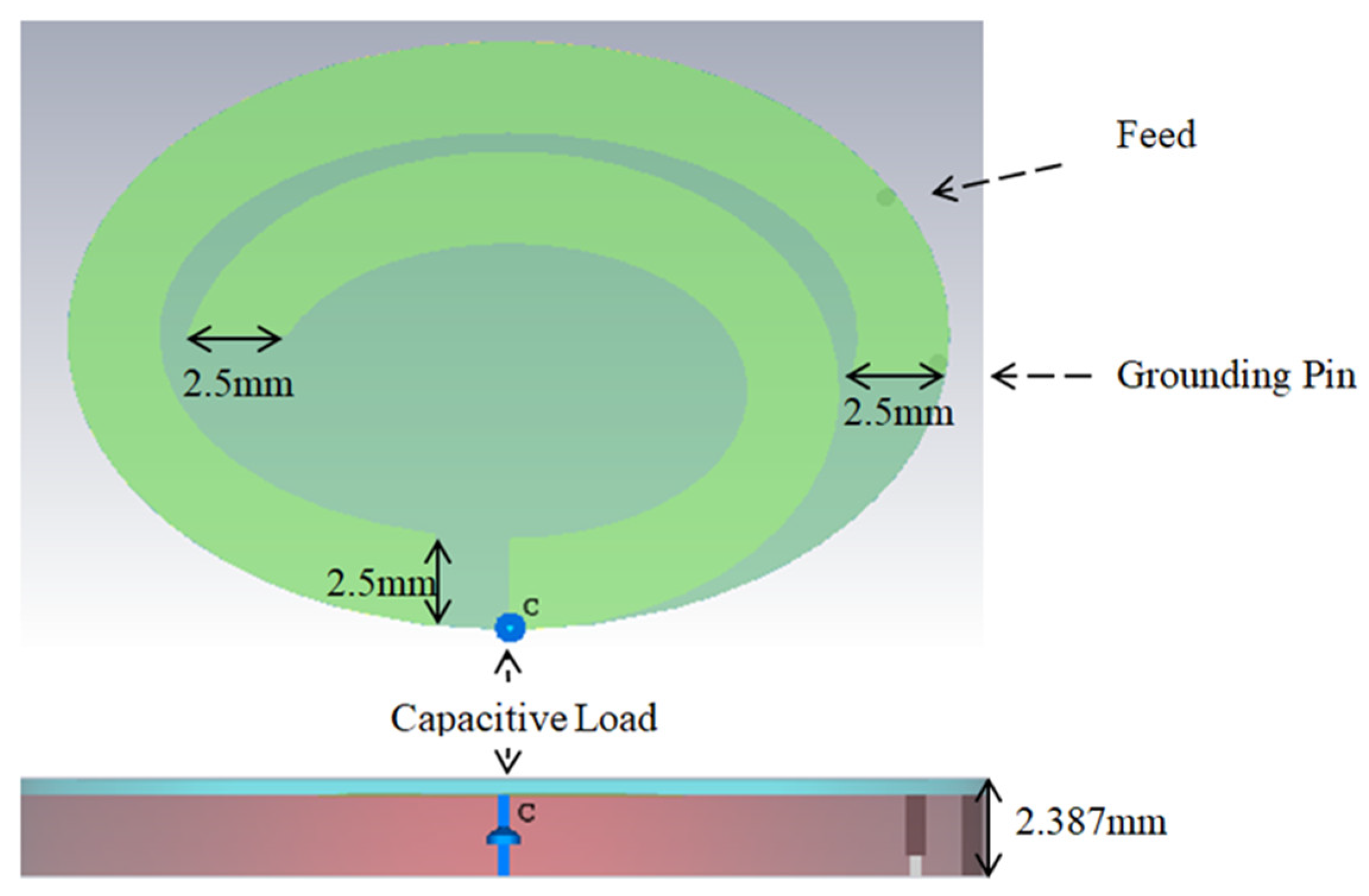

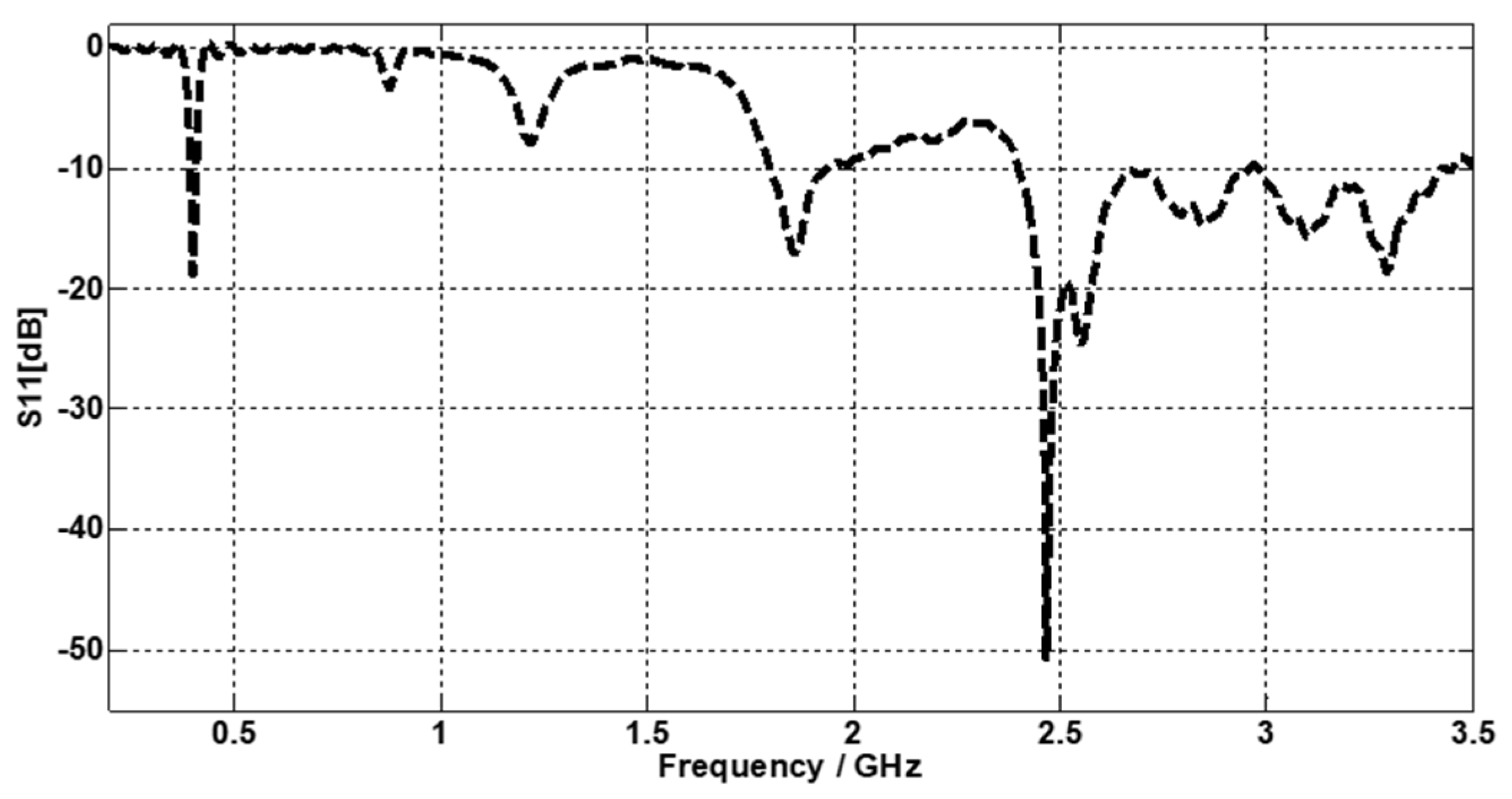

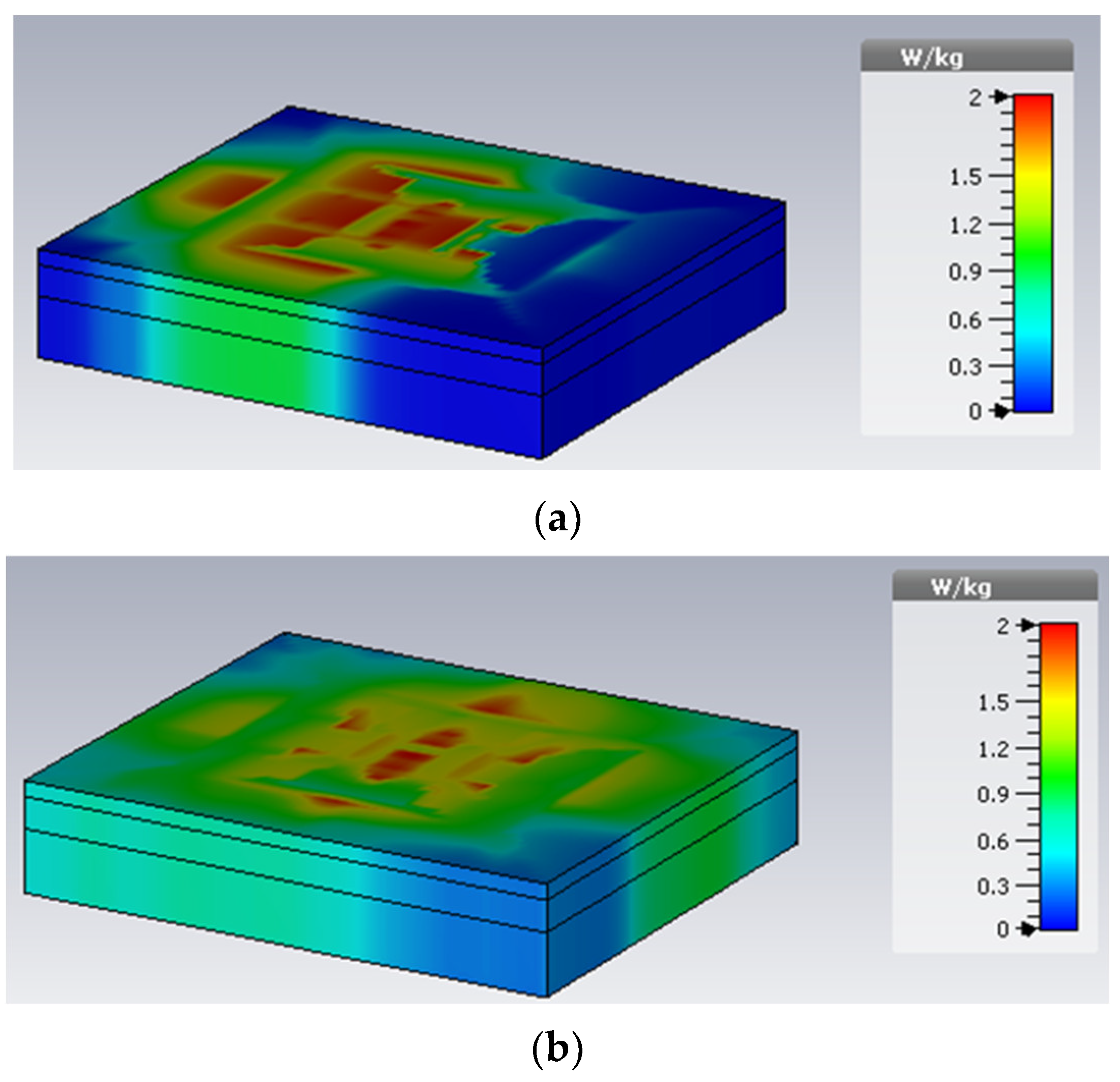
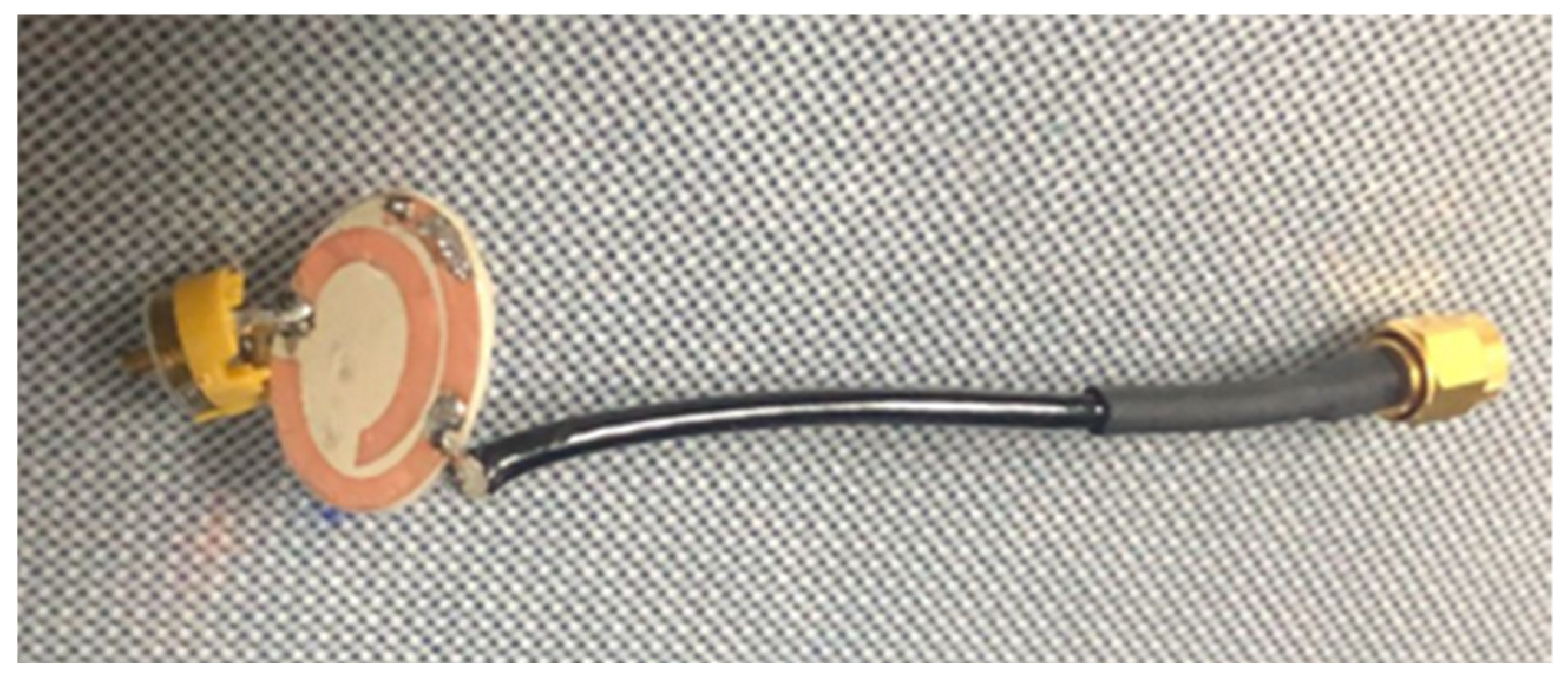


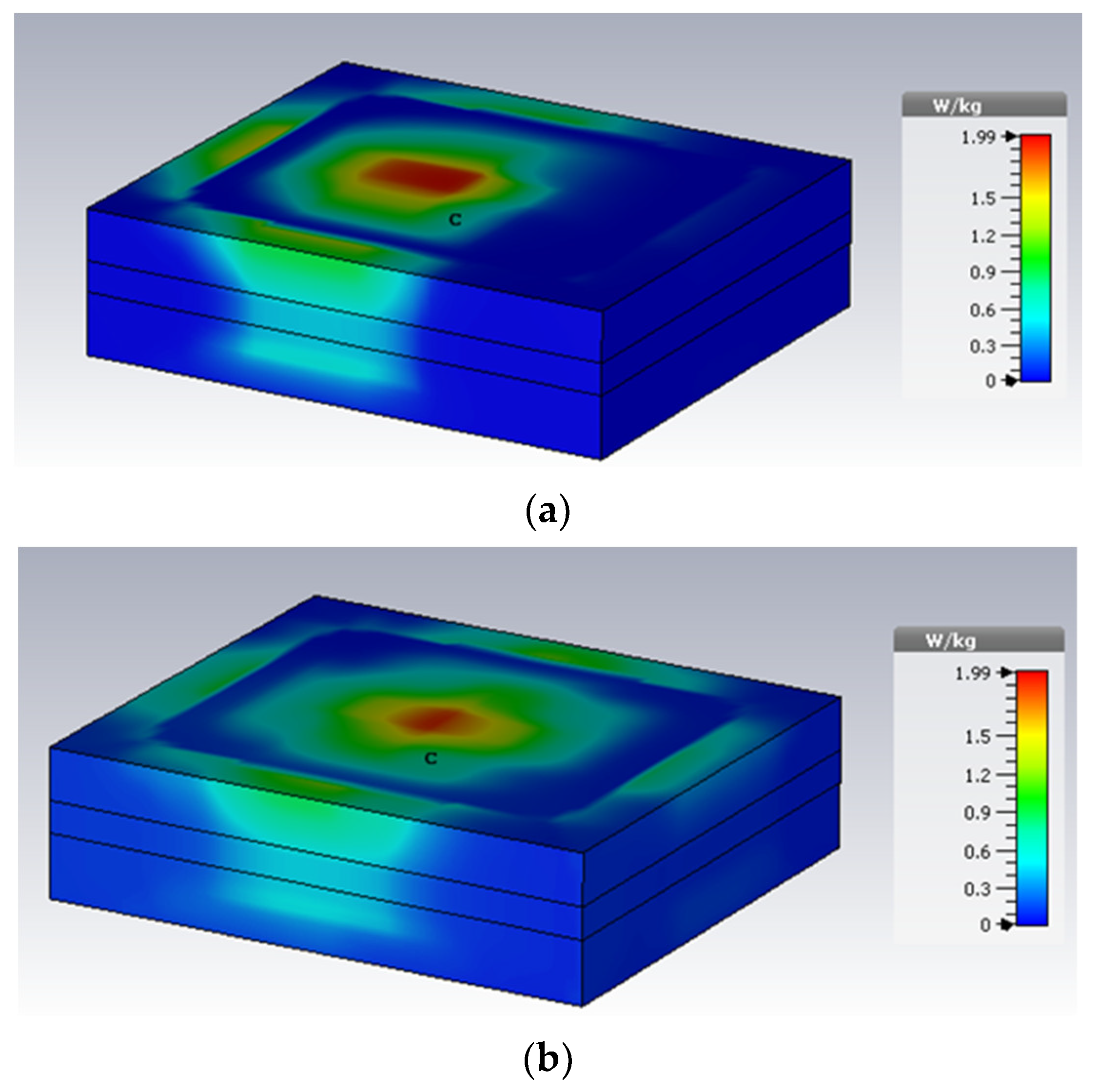

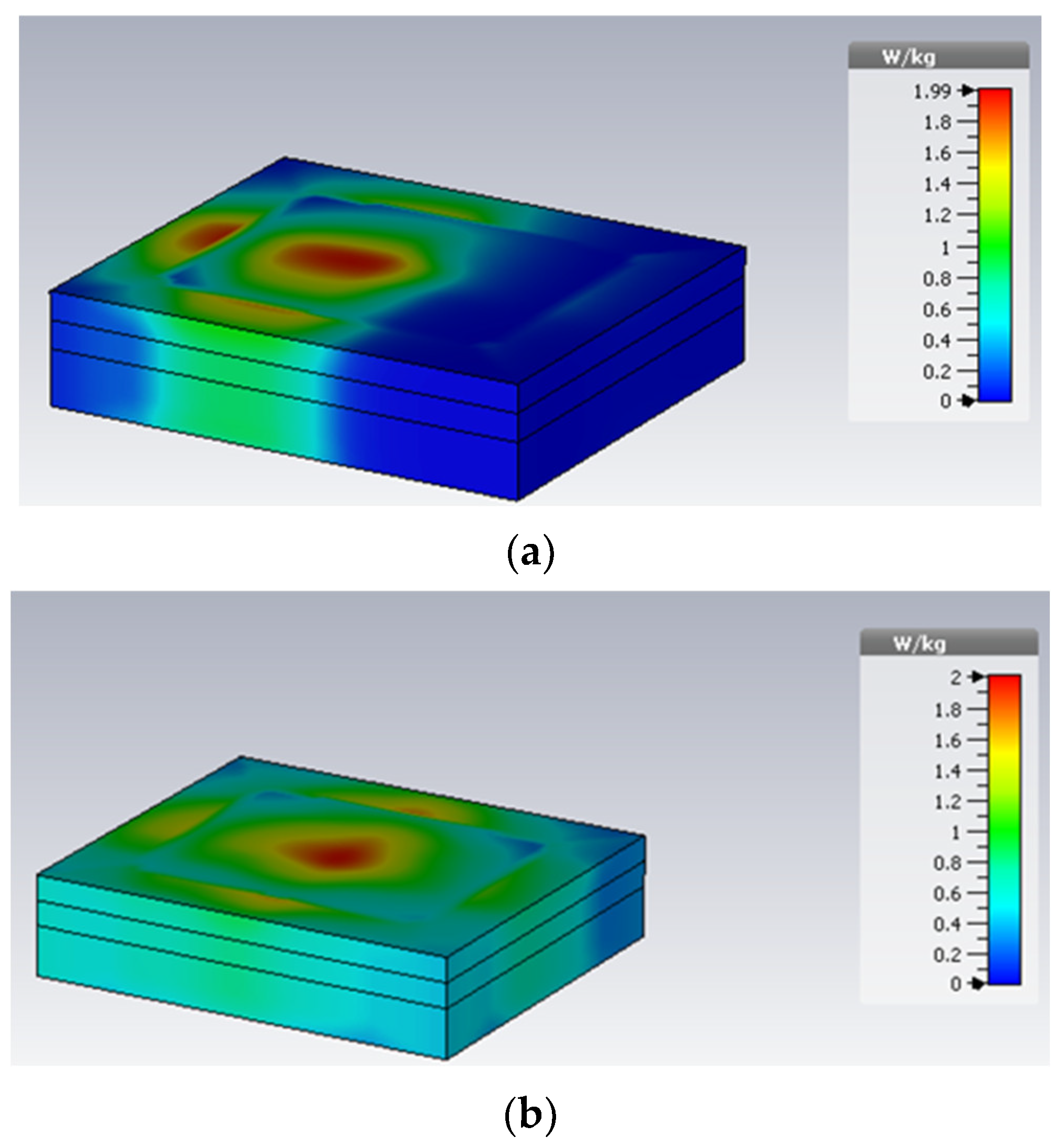

| Simulated SAR Values | SAR (1 g Model) | SAR (10 g Model) | ||
|---|---|---|---|---|
| MICS | ISM | MICS | ISM | |
| 189.42 W/kg | 124.246 W/kg | 42.0014 W/kg | 41.7769 W/kg | |
| SAR limits | 1.6 W/Kg C95.1-1999 | 2 W/Kg C95.1-2005 | ||
| Calculated maximum input power | 8.43 mW | 12.85 mW | 47.5 mW | 47.8 mW |
| Three Layer Tissue Model | Reflection Coefficient (dB) | Bandwidth (MHz) | Gain (dB) | |||
|---|---|---|---|---|---|---|
| MICS | ISM | MICS | ISM | MICS | ISM | |
| Skin Layer | −21.84 dB | −32.56 dB | 67.77 | 109.2 | −36.24 dB | −7.74 dB |
| Fat Layer | −23.15 dB | −22.38 dB | 22.51 | 591.7 | −29.57 dB | −3.83 dB |
| Muscle Layer | −18.79 dB | −50.71 dB | 13.61 | 1100 | −30.04 dB | −1.3 dB |
| Ref. | Substrate | Frequency Bands | Antenna Size (mm2) | Gain (dB) |
|---|---|---|---|---|
| [6] | RO3010 | MICS | (32 × 24) | −18 |
| [7] | RO3010 | MICS, ISM | (27 × 19) | −30.14, 2.45 |
| [10] | FR4 | ISM | (29 × 28) | 4.86 |
| [12] | Kapton polyimide | ISM | (10 × 10) | −9 |
| [15] | polyimide | ISM | (13 × 13) | −6.3 |
| This work | RO3010 | MICS, ISM | (12 × 8) | −30.04, −1.3 |
Publisher’s Note: MDPI stays neutral with regard to jurisdictional claims in published maps and institutional affiliations. |
© 2022 by the authors. Licensee MDPI, Basel, Switzerland. This article is an open access article distributed under the terms and conditions of the Creative Commons Attribution (CC BY) license (https://creativecommons.org/licenses/by/4.0/).
Share and Cite
Salama, S.; Zyoud, D.; Abuelhaija, A. Modeling of a Compact Dual Band and Flexible Elliptical-Shape Implantable Antenna in Multi-Layer Tissue Model. Electronics 2022, 11, 3406. https://doi.org/10.3390/electronics11203406
Salama S, Zyoud D, Abuelhaija A. Modeling of a Compact Dual Band and Flexible Elliptical-Shape Implantable Antenna in Multi-Layer Tissue Model. Electronics. 2022; 11(20):3406. https://doi.org/10.3390/electronics11203406
Chicago/Turabian StyleSalama, Sanaa, Duaa Zyoud, and Ashraf Abuelhaija. 2022. "Modeling of a Compact Dual Band and Flexible Elliptical-Shape Implantable Antenna in Multi-Layer Tissue Model" Electronics 11, no. 20: 3406. https://doi.org/10.3390/electronics11203406






